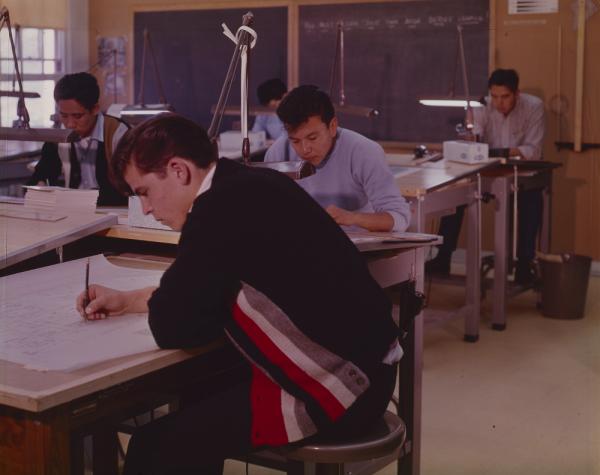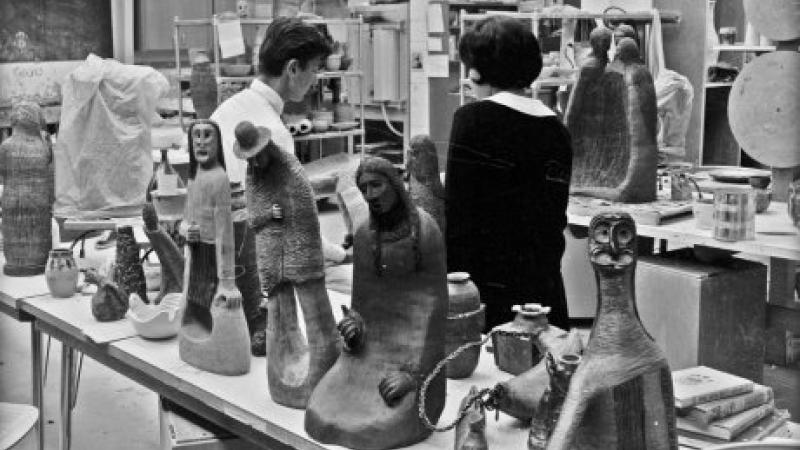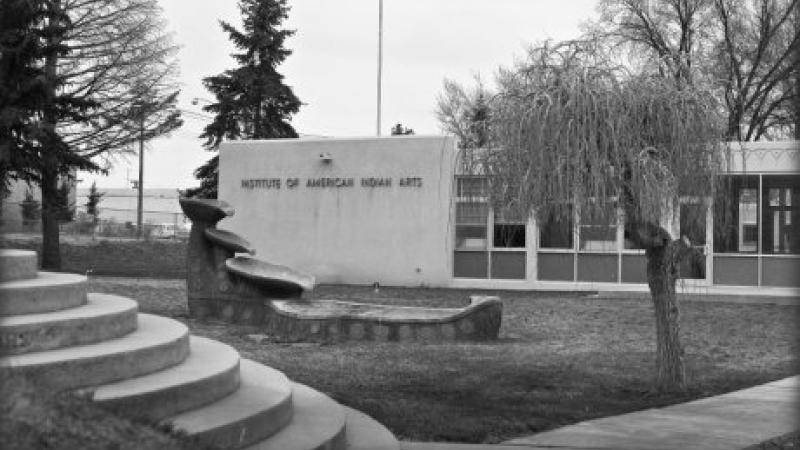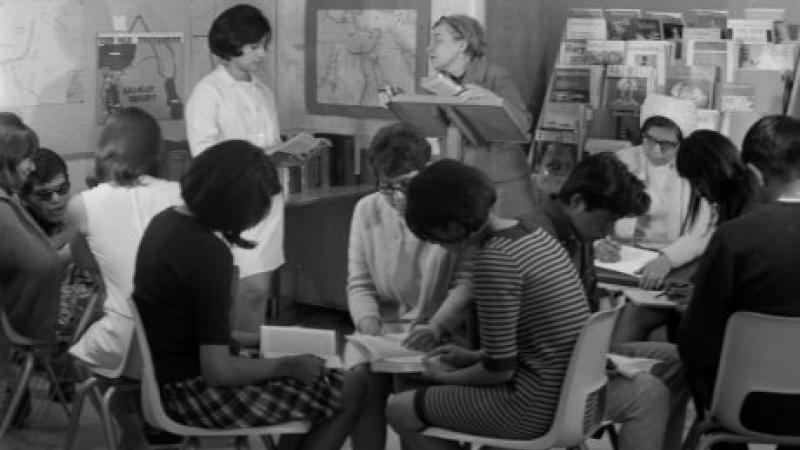50 States of Preservation: Institute of American Indian Arts in Santa Fe, NM

Drafting class in the Commercial Arts classroom, Institute of American Indian Arts, Santa Fe, New Mexico, 1965. Kay V. Weist Negative Collection, IAIA Archives.
Image courtesy the Institute of American Indian Arts.

Drafting class in the Commercial Arts classroom, Institute of American Indian Arts, Santa Fe, New Mexico, 1965. Kay V. Weist Negative Collection, IAIA Archives.
Image courtesy the Institute of American Indian Arts.
This feature is part of a series we call “50 States of Preservation,” in which we are touring small and mid-sized museums, libraries, historical societies, and other repositories across the country to show how they are helping to preserve the nation’s cultural heritage. Read other entries in the series here.
Based in Santa Fe, New Mexico, the Institute of American Indian Arts (IAIA) provides a Native American art and culture-based curriculum to students from across the country. First launched as an art high school in 1962, IAIA has developed into an accredited baccalaureate institution, complete with an associated museum of contemporary Native art. IAIA is the only multi-tribal center of higher education in the United States dedicated solely to the preservation, study, creative application, and contemporary expression of Native American art and culture. To date, nearly 4,000 students have graduated from IAIA programs. Associate and Bachelor degrees are offered in cinematic arts and technology, creative writing, museum studies, studio arts, and Indigenous liberal studies as well as a low-residency MFA program in creative writing. Native students from hundreds of federally recognized tribes and other Indigenous communities from the United States, Canada, and around the world benefit from IAIA’s programs.
The IAIA archives, which are open to scholars and the general public alike, include an extensive collection of negatives and slides, literary and historical documents, and videos of Native American culture, including interviews with artists. One highlight is the work of IAIA staff photographer Kay Wiest, who documented student life, academic activities, and exhibitions at the Santa Fe campus during the 1960s. The archives also hold the first photographic inventory of the IAIA’s Museum of Contemporary Native Art, which houses numerous paintings, prints, and pieces of sculpture, ceramics, jewelry, and metalwork. One of the IAIA’s largest archival collections are biographical files on some 7,000 Native artists dating back to the 1930s; they include résumés, photographs, exhibit catalogs, newspaper articles, among other varied archival materials.
Despite its small (one full-time employee) staff, the archives is responsible for meeting the records management, archival, educational, and research needs of the entire institute. An NEH grant in 2004 enabled a preservation assessment of and the purchase of supplies for the museum collection, leading to the installation of environmental monitoring equipment and the development of integrated pest management procedures. A second NEH award, in 2006, allowed archivist Diane Bird to conduct a similar assessment of the IAIA’s archival holdings. Subsequent grants in 2010 and 2015 led to the purchase of much-needed preservation supplies. Through the most recent NEH award, IAIA staff were able to rehouse more than 14,000 photographic slides, stereoscopes, color transparencies, and negatives into protective sleeves and envelopes. Reflecting on these efforts, IAIA Archivist Ryan Flahive observed: “Considering the Archives is a one-man operation with limited assistance from student workers, this [rehousing] project was certainly a success—we thank the NEH for the opportunity to further preserve the history of IAIA.”
In every state, NEH supports organizations that preserve humanities collections. Preservation Assistance Grants for Smaller Institutions (PAGs) fund projects that help safeguard photographs, letters, documents, prints, moving images, sound recordings, maps, drawings, artworks, textiles, furniture, and artifacts, making them available for future generations. These collections help researchers, educators, and members of the public better understand the complex stories of the various cities, towns, and tribal groups that make up our nation.
Since 2000, NEH has made nearly 2,000 Preservation Assistance Grants to small and mid-sized organizations to preserve and care for their humanities collections. In all 50 states, the District of Columbia, and Puerto Rico and the Virgin Islands, PAG awards have funded preservation assessments, purchase of shelving, environmental monitoring equipment, and preservation supplies, and training for staff. Organizations in all states and U.S. territories are eligible to apply, and the program encourages applications from those new to NEH. The next application deadline Preservation Assistance Grants for Smaller Institutions is May 1, 2018. If you have any questions about this grant program, please contact us at @email or 202-606-8570.




